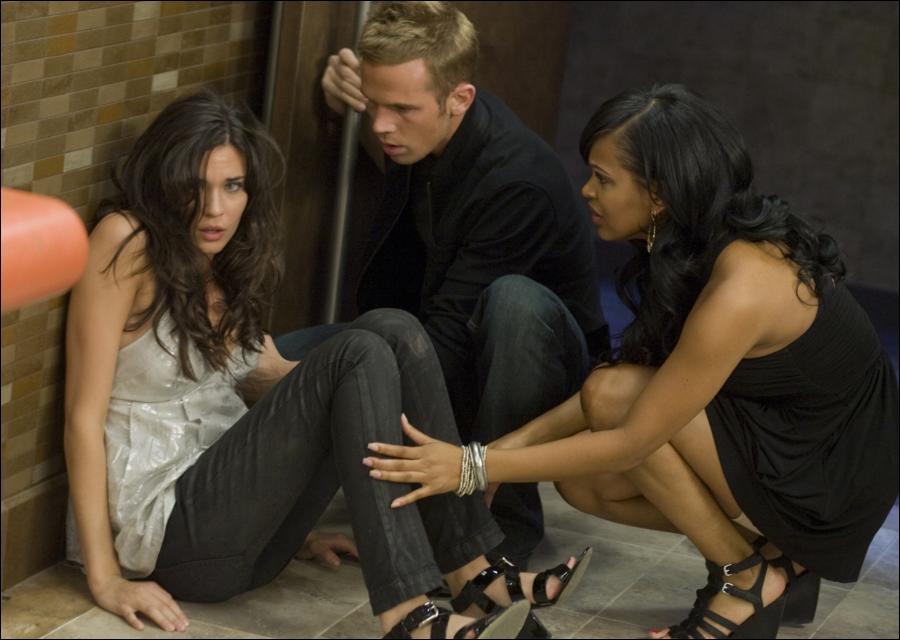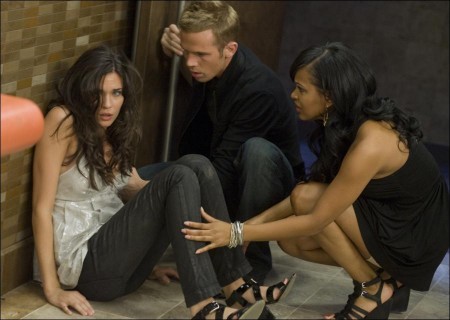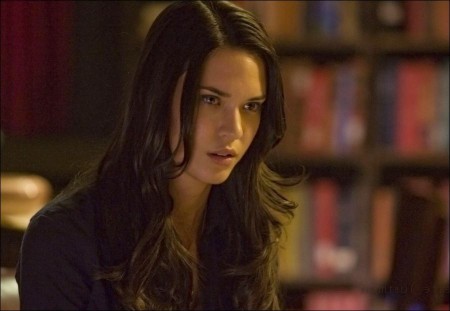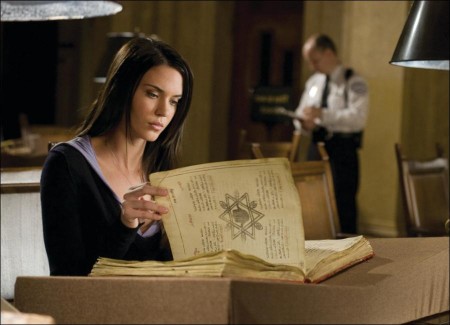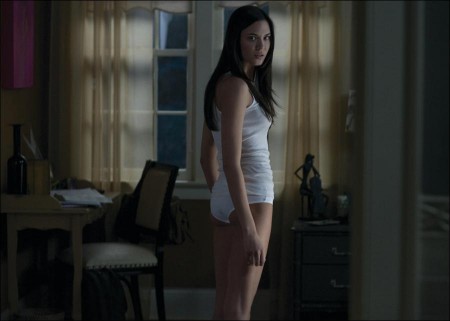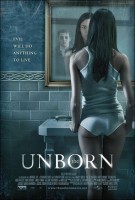The Mystery of Twins: The Unborn Is Conceived
“I am thankful to You, eternal King, who has mercifully returned my soul within me. Your faithfulness is great.” – Modeh Ani, Jewish prayer said upon waking up.
For David S. Goyer, the concept of twins was a subject he had long found both fascinating and unnerving. While on a trip to Chicago to visit his wife, Jessika, on the set of a film she was producing, Goyer would become inspired by the subject matter to develop the script for The Unborn.
“David has been preoccupied with twins for a long time,” says EP Jessika Goyer. “There are a lot of great unanswered mysteries in the medical history of twins, and the more he researched it, he realized there were ways to write about them that could be very scary. We both wanted to do a horror film that felt fresh and relied on scares derived from our worst possible nightmares…instead of just a movie relying on torture and gore. We looked to movies we felt were really scary, like Rosemary’s Baby and The Exorcist, and considered the moments in those films that chilled us to the bone.”
David Goyer felt what was most interesting about those landmark movies is that, while they could easily be called horror films or supernatural thrillers, they are also intense dramas. “When something’s real, it scares me,” he offers, “and those films have an air of realism to them that offers the dramatic intensity I wanted in this film.”
Of his interest in the subject matter, he continues: “I’ve always found twins to be scary. Jessika and I were having dinner at a restaurant in Chicago, discussing the subject, when the idea came up about someone being haunted by their unborn twin. I’ve heard stories about one twin dying during the pregnancy, or even during delivery, and I started to think about what kind of psychological effect that could have on the surviving twin.”
With the loose idea for the script beginning to take shape, the writer/director traveled to his good luck writing spot in Wyoming to start fleshing out the story of The Unborn. The celebrated comic-book author, known for his ability to imagine entire worlds down to their minutiae, began to research what was known of twins. This led him to uncover material about gruesome experiments by Nazis upon children during the Holocaust.
Led by sadistic researcher Dr. Josef Mengele, Nazi scientists believed that members of the Aryan race could have perfect blue eyes and were willing to torture Jewish twins in concentration camps to find the best way to alter pigmentation. They conducted a series of painful experiments to inject lethal dyes into the eyes of children to make their natural dark eyes turn blue.
Goyer’s studies also led him to examine ancient Jewish folklore, from which he learned of the ancient spirit called a dybbuk. He found that these cursed, wandering souls who can enter the bodies of the living have been a part of mythology for centuries. Discussing the behavior of the vengeful entities, with whom reason is impossible, Goyer says: “Like a moth tapping against the glass trying to get into light, they keep trying to come back into a body, because they can’t go into heaven.”
With The Unborn’s tale filled with spiritual and religious undertones, Goyer comments on why spirituality and archaic symbols resonate so profoundly in the horror genre: “Religion and horror films always seem to go hand in hand,” he believes. “Most religions address some form of an afterlife, supernatural figures, entities and ghosts. It’s a mystery we didn’t understand 3,000 years ago, and we still grapple to come up with explanations-which makes it a natural fit for genre films.”
The original subject matter of Goyer’s script resonated with Platinum Dunes partners Michael Bay, Andrew Form and Brad Fuller. With a history of producing successful movies that include the 2003 remake of the 1974 gore-fest The Texas Chainsaw Massacre, as well as The Amityville Horror, The Texas Chainsaw Massacre: The Beginning and the upcoming Friday the 13th, the filmmakers were looking to find an original script for Platinum Dunes to produce.
Producer Fuller admits that their production house is sent a number of horror scripts, but he and his team weren’t ready to put another remake on their slate. He offers, “We loved David’s script, and the level of writing was so much higher than what we were receiving at the time. From the inception of Platinum Dunes, Michael, Drew and I have always talked about making a film that dealt with religion and exorcisms. It’s a subject matter that is very frightening and resonates with audiences.”
Adds producer Form: “It’s not every day that you get a spec script from a writer like David Goyer, who was coming off of Batman Begins, the entire Blade franchise and The Dark Knight. We jumped on it, and it was exactly what we were looking for.”
For Platinum Dunes, having Goyer direct the film was the only option. “It’s not fair to assume that everyone who writes a great script can direct one,” states Fuller, “but David had directed three movies, and in talking to him, he understood where all the scares were. Traditionally, choosing a director is our hardest decision, but this was the easiest director choice we’ve made in the history of our company. There was no discussion; it was going to be David directing the film, or we weren’t going to make it.”
For Goyer, the decision to direct was heavily influenced by two of his previous leading actors. “I had known about Platinum Dunes for a while and happen to be very good friends with Jessica Biel and Ryan Reynolds, who I directed in Blade: Trinity,” he says. “They went on to do The Texas Chainsaw Massacre and The Amityville Horror and said very good things about working with Michael, Andrew and Brad. Platinum Dunes had a deal with Rogue Pictures, who was looking for a genre movie, so it seemed like perfect timing and a good fit, creatively.”
With Goyer’s script firmly anchored by the character of Casey Beldon, a young woman who realizes a cursed spirit has been stalking generations of her family, the filmmakers began the task of finding the right young actress to play the pivotal role, as well as a cast to share in her terror.
Ready to Be Born: Casting the Film
“Ten is the number of the Sephirot, which are the known attributes of God. The idea is that these 10 form a protective circle around the afflicted person.” -Rabbi Sendak on the exorcism of Casey Beldon
The Unborn begins and ends with Casey, an attractive college student who starts to experience strange visions and physical manifestations of an evil curse. This takes her down the path to search for the truth about her family’s history. Goyer envisioned the character as a studious and bright young woman, but also someone who is a bit of a loner. She has had a very rough time of it, living with the pain of a mother who supposedly committed suicide when Casey was a girl.
Interestingly, instead of beginning with the character and building the plot around her, Goyer wrote Casey as a natural product of the events and environment he imagined for the story.
He elaborates, “I think there are two kinds of writers: one who writes characters first and then embellishes the plot, and the other who writes the plot first, then fills in the characters based on the plot. I’m definitely in the latter group.”
When looking for the right performer for the role, the production team cast a wide net. “With all of our movies, we’ve always looked to younger actors and actresses who do not have a long list of credits,” notes Fuller. “It affords them an opportunity to star in a movie, and we’re able to see virtually every young actor and actress in Hollywood for these roles.”
The filmmakers auditioned hundreds of actresses, but Odette Yustman, who starred in the groundbreaking hit Cloverfield and the television series October Road, was a standout. Of The Unborn’s lead, Jessika Goyer compliments:“Odette is absolutely stunning and a really talented actress, but she also feels like someone who could live next door to you. She has this quality where you want to be her friend and protect her and see her through her character’s nightmarish journey.”
Recalls director Goyer of Yustman’s audition: “She blew everyone away, and fortunately it was one of those rare moments where everyone agreed she was the right person for the role.”
Yustman was drawn to the part from her first read-through. Relating her sympathy for the young woman, she states: “Even though Casey pretended she was over her mom’s suicide and she was OK, there was always something that haunted her. She can’t really talk about her mom’s death with her father because it’s so difficult for the both of them.”
As she read through Goyer’s screenplay, Yustman understood that Casey has to become stronger than she ever imagined if she hopes to undo the curse that has plagued her family for generations. The performer explains: “At first, she thinks she’s hallucinating these recurring dreams. But then, things get creepier and creepier. It’s life or death for Casey if she doesn’t find out what’s going wrong.”
During initial filmmaker meetings and throughout production, the actor proved to be just as tough as the character she would portray. “Now that I’ve done a few films, it’s interesting to see how different producers deal with the auditioning process,” laughs Yustman. “After I was three auditions deep, I went to the Platinum Dunes offices and we all just talked about the film and had a good-natured verbal sparring. It was a lot of fun.”
Assisting Casey in her journey to unlock the mysterious visions that haunt her is her boyfriend, Mark Hardigan, played by Cam Gigandet. The actor, who most recently starred as the seemingly unstoppable vampire James in the global hit Twilight and as hard-ass ultimate fighter Ryan in Never Back Down, was coming from two films in which he had played a villain. For The Unborn, he was excited to play against that type. Well, for part of the film at least.
“It really piqued my interest when I read the script and saw the arc of this character,” says Gigandet.“Mark goes from loving someone so intensely and taking care of her…to trying to fight an evil presence that eventually takes control of him.”
His producer liked Gigandet’s ease with the duality of the role. “Cam has an edge to him that makes him very believable, and he was the perfect balance for the character of Mark,” commends Form. “We needed an actor who could play the sensitive, supportive boyfriend…then flip the switch and become this conflicted, evil character.”
When Casey investigates the cause of her mother’s apparent suicide, it unknowingly leads her to cross paths with her maternal grandmother, Sofi Kozma, a Holocaust survivor and the spiritual heart of the film.Casey’s move toward Sofi begins after Casey discovers she has contracted heterochromia (a condition in which people have two differently colored eyes). Her brown eyes are beginning to turn bright blue…a sign that the demon is near.
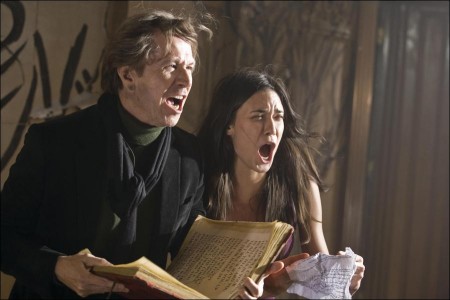
Portrayed by four-time Academy Award nominee and two-time Emmy Award winner Jane Alexander, Sofi provides an explanation for the mysterious corporeal changes and surreal visions Casey is experiencing. They are the direct result of a cursed bloodline that includes Casey’s twin brother, who died during her mother’s pregnancy.
The woman David Goyer calls a “wonderful, seasoned actress” brought gravitas to the cast in her portrayal of the long-tortured Sofi. He commends, “With talent like Jane coming on board, it makes our film one with real dramatic teeth in it.”
Alexander took the part that she felt was a “lovely role because of the trajectory of the character.” She reflects, “Sofi starts off in this ambiguity and ends up a really good person who has been beset all of her life.”
For the film, Alexander had the chance to exercise a newly acquired Hungarian accent. “Very few people speak Hungarian,” says the actor. “It’s one of the hardest languages in the world, but I only had to learn the accent, which is much easier. I had a lovely Hungarian woman, who was a Holocaust survivor, work with me in preparation for speaking with the accent.”
Accompanying our heroine to the retirement home where Sofi lives is Casey’s best friend, Romy Marshall, played by Meagan Good. Sympathetic to her plight, Romy tries to help her friend from mentally self-destructing. “Romy and Casey have grown up together, and she looks out for her,” explains Good of her character’s relationship to the protagonist. “Romy is actually pretty superstitious, and she is afraid Casey will end up spiraling down the same path as her mother.”
Provides her director: “Meagan is an amazing actress. I had seen her in a wonderful independent film called Brick, and she was also in Stomp the Yard. Her character is the light to Casey’s darkness. Casey is serious and very studious, which is completely opposite of Romy, who is very lighthearted and carefree.”
With Sofi’s assistance, Casey learns of her family’s cursed lineage and why she is being plagued nightly by dreams and daily by visions of an evil entity. Her only hope to stop the madness lies with Rabbi Sendak, a spiritual advisor played by renowned actor Gary Oldman.
For the filmmakers, landing Oldman was a coup. “We weren’t sure if Gary would want to do the film,” admits Fuller. “David wrote Batman Begins and the story for The Dark Knight, and in both films, Gary played a well-written character. We thought since he had a great rapport with Gary, we could get the script to him and hope for the best.”
For Goyer, persistence paid off with the man who became one of Bruce Wayne’s closest allies, Commissioner Jim Gordon, in Goyer’s take on The Dark Knight. “Gary is a true artist and one of my top five favorite actors in the business,” he notes. “We felt like we had won the lottery because he anchors the film, and as it turns out, he is a big fan of the horror genre and science-fiction films.”
Oldman explains his character’s crucial role in The Unborn: “Sendak is a progressive rabbi, and Casey comes to him because she is being haunted by an evil spirit and needs an exorcism. He is pretty skeptical at first but recognizes how troubled Casey is and grants her request to translate her Book of Mirrors [Sefer Mar’ot], which she believes will, essentially, save her life. After Casey leaves his office, he begins to work on the translation when he hears a sound in the synagogue. He investigates and sees a rabid dog with its head upside down…which convinces him that there’s some truth to what Casey is saying.”
For the exorcism of Casey Beldon, Oldman was required to recite mouthfuls of dialogue from a very foreign tongue. He says, “The exorcism itself involves a Hebrew psalm. It is, in fact, a prayer. I’m not Jewish, and I don’t speak Hebrew, so I worked with someone who led me through the meaning and the pronunciation. Through that work, I connected with the character, much the same way that I prepared for the film Immortal Beloved, where I played Beethoven. Once I became familiar with it and really got it in my mouth.”
After Sendak agrees to perform the exorcism, he enlists the help of his old friend, Father Arthur Wyndham. The filmmakers cast British actor Idris Elba for the role. Goyer wanted him to play against type, so the first time the audience meets Father Wyndham, he’s shown as a tough guy on the basketball court.
Of Elba, Goyer says, “He’s a phenomenal actor. A lot of people don’t realize he’s British, so it’s disconcerting when you talk to him for the first time, because he’s got this jaunty accent…but the character he plays in a lot of movies and on TV is a tough American.”
Rounding out the cast of The Unborn is James Remar as Gordon Beldon, Casey’s father, and Carla Gugino, who makes a cameo appearance as Janet, Casey’s deceased mother. “We were very fortunate to get a roster of wonderful actors to play supporting roles in this film,” says Goyer. “James plays Casey’s father. He’s a great actor and a close friend for almost 10 years.”
After an extensive search, the two main children in the script were chosen for The Unborn. Ethan Cutkosky was cast at the terrifying, ghastly young boy Barto, the form in which the evil entity appears to Casey, and Atticus Shaffer was selected to play one of the first subjects of the dybbuk’s possession, young Matty Newton.
“I’ve never seen a horror film with as deep and talented a cast as we have,” concludes Fuller. “When you combine incredibly gifted actors like Gary, Jane, Idris, Carla and James with great young actors like Odette, Meagan and Cam, the quality of performances makes for an incredibly special film.”
Visualizing Terror: Shooting the Suspense Thriller
“The more we do to you, the less you seem to believe we are doing it.” – Dr. Josef Mengele, Auschwitz-Birkenau’s “Angel of Death”
On March 2, 2008, principal photography began in Chicago, the city where David Goyer first conceived of the script, as well as the location where Platinum Dunes shot The Amityville Horror in 2004.
Though the suspense thriller was originally set in Portland, The Unborn was relocated to Chicago, with production shooting its first few weeks at Barat College in the suburb of Lake Forest. Fuller explains the decision: “We made The Amityville Horror in Chicago and had an amazing crew and a great experience. We needed a city that was cold enough to snow in March, and Illinois also has a good tax rebate program. Everything lined up nicely there, as we also needed to shoot predominately in practical locations.”
The actor in the majority of The Unborn’s scenes, Odette Yustman proved to be quite a trouper as she went through production-especially when filming the key scene where Casey visits an ophthalmologist (played by C.S. Lee) after one of her eyes begins to change color. This was just one of many physically demanding scenes that tested her mettle.
“The eye doctor sequence was the craziest thing I have ever done as an actor,” reveals Yustman. “I have very sensitive eyes and was worried about wearing blue contacts. Once I realized I was going to be able to wear them, I thought everything was going to be easy…until I heard David talk about sticking a speculum in my eye. I didn’t know what the hell that thing was, but it just sounded painful. He brought it to set one day and said, `It’d be really great if you could put this in your eye.’ I replied, `What? Are you kidding me?’”
Goyer recalls filming his lead while she rested in a chair with her eyelid propped open. “Once I saw that Odette was game to do a lot of her own stunts, I wanted to make the scene really uncomfortable and get the audience really squeamish,” he laughs. “I think we ended up doing five takes, and she was a little mad at me that day.”
Another sequence that tested Yustman’s resolve involved her being covered with hundreds of potato bugs, one of the many creatures that the dybbuk possesses in its attempt to crawl up the evolutionary chain. “When I was writing this script, I found a Jerusalem Cricket [potato bug] in my backyard,” Goyer recalls. “It looked really disgusting, and I decided I wanted to have hundreds of them crawling on Casey.”
His interest in featuring the insects as co-stars proved to also be a big challenge for other teammates in the production. A “bug wrangler” (Jules Sylvester) informed Goyer that potato bugs, much like cicadas, burrow in the ground and only come up at certain times of the year. The filmmakers hired entomology students to comb the desert to gather a few hundred bugs.
Goyer proved to his performers he was open to spirited method acting. “David had the great idea to throw a bunch of them on me right before the scene,” remembers Yustman. “I reluctantly agreed, and all I could think about was those bugs crawling up inside my clothes. They’re feisty and bite! It was horrible, and I think it shows on screen because I was genuinely terrified.”
Yustman wasn’t the only performer writhing about on set. After the dybbuk begins to grow in strength, it possesses wheelchair-bound Eli Walker (played by Michael Sassone), who chases Sofi along the stairs at the nursing home. To pull off the chilling sequence, the production enlisted the help of a contortionist (Mark Steger) and top-notch special and visual effects artists.
“Eli is one of the scarier characters in the entire movie and comes out of nowhere,” says Form. “Casey goes to visit Sofi in the retirement home, and Eli is sitting benignly in a wheelchair, because he’s had a stroke.” After she leaves, “wind chimes start ringing, and the dybbuk jumps into his body and possesses him. This gives him the power to move and chase Sofi around the home…with his head twisted upside down.”
Goyer explains the process of capturing the grotesque imagery with cinematographer James Hawkinson and VFX supervisor Mitchell S. Drain: “We tossed around a lot of ideas on how to do it. Ultimately, we decided to hire a contortionist and take a life mask of the real actor, so that we could make a photo-real mask of Eli’s face. We then filmed the contortionist doing all his movements in reverse-so if he’s supposed to be crawling toward Sofi, he would actually crawl backwards-and we filmed with the cameras going in reverse at the same time.”
Over the course of her journey, Casey grows to believe that she needs a Hebrew exorcism, and she seeks out Rabbi Sendak to perform it. The ceremony is her final attempt to gain freedom from the evil dybbuk, and the exorcism sequence proved one of the most challenging scenes for the entire cast and crew. To lens this section of The Unborn, Goyer, DP Hawkinson and the team shot over a period of 10 days in an abandoned old college.
Goyer describes his approach at preparing for the climactic scene in which the wind picks up, the lights start to go crazy and, basically, all hell breaks loose. “We shot for 45 days on the film, and the exorcism scene was almost a quarter of the schedule,” he says. “The scene had to be scary, and one of the first things I did was storyboard it, because there were too many moving pieces in the sequence.”
He continues: “Typically, you shoot a film out of script order, but we didn’t want to get lost in the massive scene with all the lighting cues, wind cues and wire stunts. We decided to shoot the scene in sequence and prepped by using storyboards as our road map. We also had a couple of rehearsals with 11 stand-ins and key crew.”
For the man who plays Rabbi Sendak, the subject of exorcisms is one that he has long found intriguing. “Exorcisms and possessions are a viable reality, and I think we’re all fascinated by the supernatural,” Oldman says. “I have seen a few documentaries about exorcisms, and this film tackles the subject matter from a completely different angle. The history David’s created for The Unborn is very unique.”
For Yustman, shooting the exorcism was a new obstacle, as she had to engage in 10 straight days of intense, primal screaming. My main source of research was watching real exorcisms on YouTube,” she says. “People react differently. Some didn’t do anything, and some went crazy. It doesn’t matter how many books you read or videos you watch, nothing is going to help unless you’re physically committed to what you’re doing.”
The performer was strapped to a gurney, which had a special mechanism that made the bottom half of her body shake. Describing the process, she says, “To get me to that place of fear, I listened to songs that triggered certain emotions and thought of certain experiences I’ve had. When the cameras rolled, I just threw my body everywhere.”
Goyer praises the performance: “Odette hit it out of the park in the exorcism scene. There are lots of stunts and scenes where she’s covered in slime. There are also scenes where she gets choked and slammed against the wall. The list goes on, but fortunately, Odette is a very athletic young woman and she was up for the challenge.”
One element of shooting the sequence that caught everyone by surprise was when an earthquake shook the set during the middle of a take. A rare occurrence in Chicago, the earthquake-and the building’s residual shaking-left cast and crew wondering whether it was Mother Nature at work, special effects for the scene…or a restless spirit of another sort.
“I was working on set the night of the Northridge earthquake [during 1994 in Los Angeles], and the little shaking we had in Chicago was like a mosquito compared to that,” laughs Oldman.“But we’re making a supernatural movie, so it’s a little strange that we experienced something like that during the scene in a city that very rarely has them.”
“It was a really strange coincidence that during the first night of shooting the exorcism scene there was an earthquake,” adds Fuller. “We shot the scene in an old abandoned college. Before we started shooting, we had heard all these rumors about the building being haunted. It’s definitely a scary, freaky place, and I don’t think we could have picked a better place for an exorcism.”
Finding and transforming the old Barat College into the setting for the exorcism, as well as multiple sets for the film, rested squarely in the creative hands of production designer Craig Jackson. “We had scouted Barat more in terms of Eldon Estates, the location for Sofi’s character,” says the designer. “We scouted more than 50 different locations because the nature of the sequence, in terms of architecture, was very specific. For about a month, our location team tried to get access to the college. When we finally did, they mentioned they also had an abandoned church. When we saw it, all of our eyes lit up because the size and scale were perfect.”
The basic structure of the church proved almost as if it were designed for The Unborn. Jackson continues, “There had been some demolition work to the lower level, while the upper level was pristine and new. It became a question of tying the two together by adding some newer elements down below and distressing the upper level. We came in with graffiti artists who added their designs to the walls and brought in set dressing to this beautiful, empty room with its old leather tile floor covered with dirt. There were also very old, expensive stained glass windows on the sides, which were great, but they posed some lighting challenges.”
Compliments Goyer of the work from Jackson’s team: “I’ve been blown away with what he’s done on this film. He’s got exquisite attention to detail and does an amazing job with aging something to make it look authentic. It’s been one of those rare experiences where every time I would come to shoot a location, I was completely impressed by what Craig was able to accomplish.”
The cast and crew also enjoyed the collaborative working environment that was prevalent on set. Yustman commends: “David always kept track of the beats, the emotional level and everything else on set. He storyboarded all the supernatural sequences and really did his research. It shows on screen.”
“To really know what kind of film you’re making, it’s up to the director to set the tone,” adds Oldman.“David knew exactly what he wanted, and he had his game down. He’s very prepared, every day, and that gives you what you need as an actor.”
****
On May 2, 2008, principal photography of The Unborn concluded in Chicago. For the production team, the experience left them feeling like they had all shared in a uniquely creative journey.
“Shooting this film has been one of our best experiences,” says producer Fuller. “The actors escalated each other’s game, and it’s just been beyond any expectations we hoped for the film. David and everyone on the creative team worked extremely hard to make this film creepy and disturbing in a way that audiences haven’t seen before.”
Producer Form concludes: “We make these films and hope audiences enjoy the ride for 90 minutes. Hopefully, they can just have fun, get scared, cover their eyes a few times, scream, and at the end, walk out with a smile on their face.”
Of his gratitude to his team and hopes for the film, writer / director Goyer ends, “I am really thankful for the extremely hard work and tireless attention to detail my cast and crew gave me. Everyone came together to create many memorable, haunting images that I’m confident will resonate and linger with audiences on a psychological level.”
These production notes provided by Rogue Pictures.
Unborn
Starring: Odette Yustman, Gary Oldman, Cam Gigandet, Meagan Good, Carla Gugino, Jane Alexander, Idris Elba, Rhys Coiro, James Remar
Directed by: David S. Goyer
Screenplay by: David S. Goyer
Release Date: January 8, 2009
MPAA Rating: PG-13 for intense sequences of violence and terror, disturbing images, thematic material and language including some sexual refernces.
Studio: Rogue Pictures
Box Office Totals
Domestic: $42,670,410 (60.3%)
Foreign: $28,036,829 (39.7%)
Total: $70,707,239 (Worldwide)
